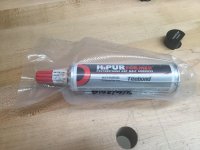charley1968
Member
- Joined
- Sep 20, 2013
- Messages
- 491
Hi folx
Living in the scandinavian outback with no Axminster or Rockler within a 500 miles,
depending on small hardware stores with more knowledge about how to build a house than how to build a table, reading about Titebond this, PU-glue that, i wonder why you folks use what you use.
Myself, i generally use PVA-glue in different mixtures and up till now, i've had no need of anything else. But i wonder if i'm missing a whole world of ways of joining two pieces of wood together.
Much obliged: A.
Living in the scandinavian outback with no Axminster or Rockler within a 500 miles,
depending on small hardware stores with more knowledge about how to build a house than how to build a table, reading about Titebond this, PU-glue that, i wonder why you folks use what you use.
Myself, i generally use PVA-glue in different mixtures and up till now, i've had no need of anything else. But i wonder if i'm missing a whole world of ways of joining two pieces of wood together.
Much obliged: A.

